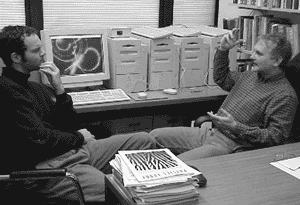
|

|
|
|
|
| | VOLUME 29, NUMBER 25 | WEDNESDAY, MARCH 24, 1999 | ISSN 1199-5246 | | |
|
|
||
|
|
York physicists create super Mac By Beverley Else
York's two musketeers Chris Stewart (left) and Roman Koniuk, Department of Physics and Astronomy, working with D'Artagnan York physicists, Professor Roman Koniuk and doctoral student Chris Stewart, in need of a supercomputer for their research and lacking the hundreds of thousands of dollars needed to purchase one, simply built their own. Going against the grain in a UNIX and PC dominated environment, and utilizing funds from a $20,000 NSERC grant, they did it with five Power Mac G3's, fast-ethernet networking and parallel-processing software. The result, the "D'Artagnan Cluster", enables them to do some serious number-crunching without standing in line to rent time on an off-campus super computer. Named for the hero in The Three Musketeers, D'Artagnan is the first of the five computers. The others, aptly named Athos, Porthos, Aramis and Richelieu, reside compactly in a small office in the Petrie Science Building, and are kept busy continuously with calculations. "They work in parallel, not sequentially," explained Stewart, "It's a team effort, like the musketeers." The researchers heard about clustering Macintosh computers from "Project Appleseed", underway at UCLA. Although the projects are scientifically very dissimilar, the use of multiple computers sounded like the perfect solution to Koniuk and Stewart, both cost effective and simple. The physicists at UCLA lent a friendly hand with the basics, a program was written for the project, and the components purchased last October. D'Artagnan is working perfectly. Amazingly, Koniuk and Stewart are not computer experts. "Most people assume, incorrectly, that setting up this type of cluster would be routine for us, given the complex work that Stewart and I do," said Koniuk. "It's just not so! My specialty is physics, not computers." "But the process was simple," he continued. "We just hooked them [the computers] together and they talked. These five computers do calculations at ten times the speed of a relatively fast workstation." "And that matters when we're talking calculations that take days, months, up to a year," added Stewart. "Effectively this means that a significant piece of work can be completed in one month instead of one year." Koniuk and Stewart study a branch of particle physics known as Quantum Chromodynamics (QCD), which describes the interactions between quarks, the tiny fundamental particles that are constituents of all matter. More specifically, they work in an area called Lattice QCD. "Lattice QCD is the most promising approach to studying quarks. We pretend that space-time, normally thought of as continuous, is a lattice of discrete space-time points. This allows us to numerically model the complex forces between quarks," explained Koniuk. One of the problems Koniuk and Stewart study is how quarks bind to form neutrons and protons. The success of the D'Artagnan cluster has roused a great deal of interest from universities around the world, from Vancouver to Adelaide, Australia, and fits nicely with Apple Corporation's move into research and higher education. "While Apple was always strong in the graphics and desk top publishing markets, with the new clustering idea, they are beginning to see a market in research/education," said Koniuk, adding that software companies are beginning to build what will soon become off-the-shelf programs for researchers. "It's nice to see the little guys [Macintosh] getting some credit," he concluded. "Science has been PC and UNIX based for years, but this has been an eye opener for many researchers." For further information about the D'artagnan project check the following Web-sites: http://turing.sci.yorku.ca/course ware/PHYS1010/dartagnan.html |
|
| | Current Issue | Previous Month | Past Issues | Rate Card | Contact Information | Search | |
